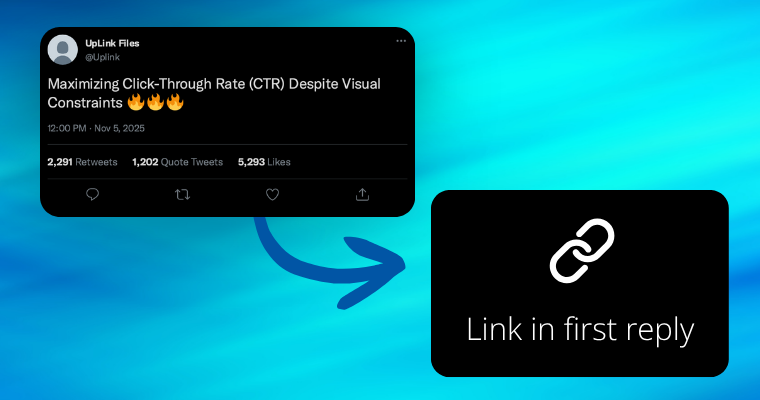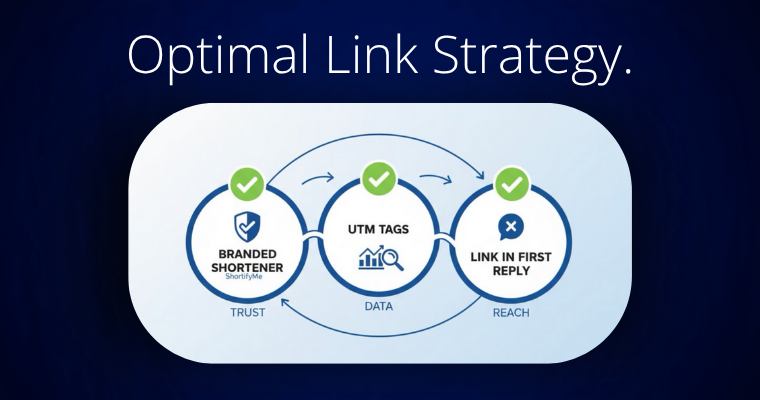Executive Summary: What t.co is and Why X Uses It?
T.co is the mandatory link-shortening service that X (formerly Twitter) uses for every URL shared on the platform. Its function is twofold: first, it operates as a required, real-time security gateway, protecting users by checking every link against known malware and phishing threats. Second, it functions as X’s core data layer, allowing the company to accurately track all click-through rates, geographic sources, and user engagement across its global network.
The Basics of t.co: How X’s Link Shortening Works?
How the t.co Redirect Works (The Technical Flow)

When you submit a post containing a link, X instantly replaces your original URL (like https://yourdomain.com/long-article) with a short, unique t.co link (e.g., https://t.co/XYZ123). This process is known as link-wrapping.
The click itself uses a standard HTTP 301 or 302 redirect. This means when a user clicks the t.co link, X’s servers record the data, perform a security check, and then immediately send the user to the original destination URL. Critically, the original destination URL is masked from users but is recorded and analyzed by X’s proprietary systems for tracking purposes.
The Key Data Points t.co Tracks

The t.co system gathers more granular, real-time data than simple on-platform engagement metrics like impressions or favorites. This rich data is vital for both X’s advertising partners and content creators looking to prove ROI.
Key data collected by the t.co system include:
- Time of Click: The exact moment the user engaged with the link.
- User ID: The anonymized ID of the user who clicked.
- Geographic Location: The general area or country of the user.
- Device Type: Whether the click originated from a mobile phone, desktop browser, or tablet.
- Operating System: Details about the user’s software environment.
The Essential Benefits of the t.co System:

Real-Time Security and Phishing Prevention (The Critical Role)
The most valuable function of the t.co system today is its role as an intermediary security scanner. Before any user is redirected, the system checks the final destination against known databases of malicious sites, malware distributors, and sophisticated phishing URLs. If the destination is flagged, the user is blocked and shown a security warning instead of being sent to the dangerous site.
Data Integrity and Granular Click Tracking
For brands and marketers, t.co ensures that click metrics are reliable and non-inflated. Since X controls the link structure, it can provide highly accurate counts of unique clicks, which is essential for reporting on campaign performance and demonstrating the value of X traffic. This data layer is central to the platform’s ability to monetize.
Handling Character Limits (The Legacy Benefit)
While X now supports longer posts for premium users, the original benefit of shortening long URLs to fit the legacy 140-character limit remains a factor. Even today, a short, clean t.co link contributes to a more streamlined and professional post aesthetic, especially when composing shorter, high-impact messages.
Navigating the Challenges of X’s t.co System:
The Phishing Problem: Mitigation Strategies for Link Trust

The Challenge: Despite X’s security scans, sophisticated threat actors sometimes exploit the t.co wrapper itself. They use newly registered or throwaway domains that haven’t yet been added to security blacklists, leveraging the trust placed in the t.co domain to trick users into clicking malicious links.
Actionable Solution:
- Verified Status: Maintain a Verified Status badge on X to give your links a visual trust signal.
- Multi-Layer Security: Use a branded third-party URL shortener (like Shortifyme) before posting to X. This provides an additional layer of domain authority and security filtering, routing users through two trusted checks (your branded shortener and then t.co) before they reach the final destination.
Solution: Maximizing Click-Through Rate (CTR) Despite Visual Constraints

The Challenge: X’s format often reduces external links to a small link preview card with limited visual space for images or detailed text, which can suppress clicks.
Actionable Solution: Focus on optimizing the accompanying text in your post. Do not rely on the link card to sell the click.
- Write Compelling Copy: Craft curiosity-driven or value-driven copy that directly relates to the linked content.
- Clear CTA Placement: Ensure your Call-to-Action (CTA) is strong and placed above the link to maximize visibility before the user scrolls past.
Strategy: When to Go External and When to Stay Native?

The Challenge: The persistent belief in the “link tax” that X’s algorithm suppresses posts containing external links to keep users on the platform is a critical factor for content strategy.
Actionable Solution: Strategic Link Placement
- The ‘Reply’ Method: Post your main content without a link, focusing on engagement. Place the external link (with a clear CTA like “Link in the first reply“) in the first response to your own tweet. This boosts initial reach and engagement on the main tweet, increasing overall visibility before the redirect.
- Threading: Use X’s native threading feature to provide maximum context, deliver significant value, and build anticipation on the platform before linking out for the final, deep-dive content.
Strategic Ways to Use t.co for Your Brand and SEO
Customizing Links with Third-Party Shorteners

For serious brand managers and SEO professionals, the best practice is to always use a branded link shortener first.
- The Workflow: You take your original link, shorten it using a URL shortener that supports custom domains like Shortifyme to create a branded link (e.g., mybrand.link/report). When you post this branded link on X, the platform then wraps your short link with t.co (e.g., t.co/ABC789).
- The Combined Benefit: The user sees your trustworthy branded domain, reinforcing your identity (E-E-A-T). X still handles the security check and provides its own click analytics. Meanwhile, your branded shortener provides a third layer of superior tracking and management features not available on X.
Using UTM Parameters for Superior Tracking
![]()
To fully reconcile the data you get from X with your on-site analytics (Google Analytics, etc.), you must append UTM parameters to your original link before shortening it.
- Technical How-To: Add parameters like ?utm_source=x&utm_medium=social&utm_campaign=q4report to the destination URL.
- Data Reconciliation: When a user clicks the t.co link, the click is logged by X, but the user is redirected to the destination URL with the UTM tags intact. This allows you to read and reconcile the t.co click data with detailed conversion and behavior metrics in your marketing dashboards.
The Ultimate Best Practice: Summary of Link Strategy

The optimal way a professional content creator should post links on X is to use a branded third-party shortener with UTM tags appended to the original URL and then place that link in the first reply of a high-value thread.
Frequently Asked Questions (FAQs)
Q1: Does t.co affect my website’s SEO or link equity?
No, the technical nature of the t.co redirect (typically a 301 or 302) is recognized by Google and other search engines. The redirect passes full link equity (or “link juice”) to your final destination URL. The t.co domain itself is simply a temporary wrapping mechanism and does not harm your website’s search performance.
Q2: Can I turn off t.co link shortening on X?
No. T.co link shortening is mandatory and is a core, non-negotiable feature of the X platform. It is inextricably tied to the platform’s security infrastructure and its proprietary analytics collection engine.
Q3: Does X’s algorithm treat t.co links differently than raw URLs in posts?
The t.co domain is the mechanism; the algorithm’s focus is on the destination URL and the post’s engagement rate. While the “link tax” theory (where external links get suppressed) persists, this is why the strategic workarounds in Section 4, like placing the link in the first reply of a thread, are the most effective ways to minimize suppression and maximize reach.
Q4: If X scans my t.co link for malware, why is link trust still a major issue?
X primarily scans against established blacklists of known bad domains. Sophisticated phishing campaigns often use new, throwaway domains or legitimate cloud services that haven’t been blacklisted yet, allowing them to slip past initial scans. This is why multi-layer security, using a vetted, commercial shortener like Shortifyme, is critical to building trust and providing an additional security filter.
Q5: How can I safely check a t.co link’s final destination URL without clicking it?
Since the t.co link is a security and tracking wrapper, you can safely uncover the final destination URL without actually clicking it. The safest methods include using a free online tool, often called a URL expander or redirect tracer, which will show you the original link. For technical users, you can perform an HTTP HEAD request using a command-line tool like cURL. This fetches the server header data, including the final HTTP Location header that specifies the original URL.
Conclusion & Key Takeaway
T.co is far more than a simple shortener; it is a powerful, non-negotiable security and analytics tool built into the foundation of X. For professionals in SEO and brand management, understanding t.co means moving past the debate about character limits and focusing on two strategic imperatives: leveraging UTMs for superior data and using branded shorteners for unparalleled trust and security. When you master these layers, you move beyond basic posting and optimize every single click on the platform.
Unlock Better Link Performance
True mastery of link tracking and branding requires moving beyond X’s basic wrapper. Use ShortifyMe to deploy branded links, gain deep click analytics, and build trust with every post.



